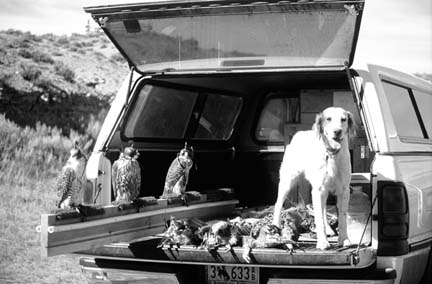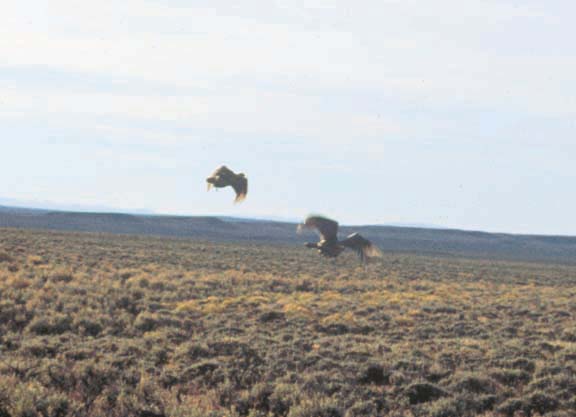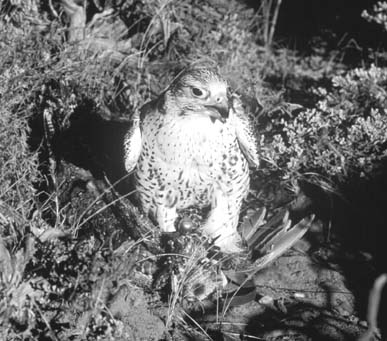"A typical grouse hawking day, you will drive
150 miles, most of it down two tracks. Your dogs, on a bad day, will run
50 miles and may produce only one slip and possibly none. So you will need
more than one dog."
The Dogs
You need good dogs to get grouse. If you find a honey hole, you'll
have grouse to spare for training. Almost mandatory for a dog new to sage
grouse. He'll need experience on them to find and point them with confidence.
This takes a trained dog about three days. This is due to the unfamiliarity
of the strong scent of fresh grouse mutes. After a few birds, your dogs
will be more reliable, but expect the occasional unproductive point. Your
dogs will have particular days of real hot streaks, doing fantastic then
for no apparent reason, start screwing up.
Some guys swear by the practice of rewarding a dog with grouse guts
after a successful flight. It's supposed to make the dog sharper with the
essence of grouse grease in his palette. I've seen this practice give a
good dog the shits, and then he'll start missing points other dogs find.
Then he'll start to dilly dally 10 feet in front of the truck for miles.
He's obviously sick! I recommend not to partake in this ritual.
How To Find The "Honey Hole"
Good grouse habitat is specific. Look for 10" high sage, very
dense with some grass sticking through. The terrain will be slightly contoured,
little hills and gullies. Most importantly, it seems like there will always
be water within a quarter to one mile of a honey hole. This could be an
irrigation ditch, river, stream, lake, or swamp.
Very tall sage or short thin sage may hold a grouse or two, but usually
will not produce. So don't waste your time or your dogs in the wrong habitat.
Grouse like to be able to see above the sage without being seen doing it
(10" sage). They like it thick so they have cover and plenty to eat.
And they don't like to go far to drink because it exposes themselves, makes
perfect sense. So find the perfect sage, pass up the grease grass and inferior
sage. Once you find the right type of sage, get off your butt and walk
around, look for the telltale "greasy grouse rooster mute." These
mutes are the size of a silver dollar, black and shiny like tar. This is
the boomers crap. Regular mutes look like chalk covered white and green
"Good and Plenty." Make sure it's fresh (touch it, taste it,
experience the true essense of good grouse hawking).
When you have found a good area, find a two track that goes crosswind.
Put out a dog and plug along at a good clip, 15 to 20 mph. Have the dog
range in front of the vehicle, command him to get off the road and into
the bush. The crosswind enables the dog to get the scent from the side
and cover much more ground than if the wind is in his face! This is an
excellent technique and it works. When he goes on point, back up your vehicle
and quietly put up your bird. When in position, go in for the flush. When
on foot, always take your telemetry so you don't have to go back to the
car for it. This may save your falcon's life by timely getting to him on
his kill before the eagle does.
The grouse hold well for points, especially when a falcon is up. The
grouse lay down on their bellies and flatten out to hide. They look like
camouflaged, flattened out footballs. They are very difficult to see and
are barely detectable. I've walked within four feet of these grouse before
I've seen them. If not pinned down from a flying falcon, these grouse will
bust for excessive noise, extended periods on point, and nervousness. Nine
times out of ten you can find one stray grouse after a large covey busts,
so look for a second chance flush or fly on spec. A typical flight on grouse
from a 300 to 800 foot pitch results in a hit 300 yards from the flush.
Beware, a grouse under pressure will bail out into fence rows and under
vehicles, so plan your flush away from these manmade obstacles; they are
dangerous.
A good hit usually brings the grouse to the ground. If your falcon
is good at whip arounds, he'll bind to the grouse and you'll have 'em.
Quickly get there to help out. If your falcon remounts, this is super good
too. Then the next reflush will really knock 'em down. But if your falcon
loses sight of the grouse during the whip around and lands on a sage bush
next to the grouse, kiss the grouse goodbye as you watch him bust out and
fly over the horizon. Your dumb bird watching this in amazement or tail
chasing him (the worst).
Eagles are a hazard; hawking is over between 11:00 am and 3:00 pm.
The eagles are soaring, and it's 80º F at this time. Soaring eagles
will spot your falcon on a kill and eat them both.

Sage supervises the crew after a good day in a "honey
hole."
The Honey Hole
Once you find a honey hole, it will produce birds for several days,
although you will notice the numbers going down and the grouse harder to
find with each successive day. After two days of pressure, they'll start
moving out into similar habitat within one mile or so. When this happens,
it's time to give the spot a rest. Go find another honey hole. If you don't,
the grouse will disperse altogether. Grouse in September and October are
easy to take because they're young, easily overheated, and plentiful. The
trick is to find them. Late season grouse is a whole new ballgame. The
grouse after November are harded up and in huge flocks. I've heard numbers
as large as 3000. It takes a bazooka to knock these birds down and access
to them can be impossible due to snow.
Other Tips
Know what permits you'll need for the state you'll be hunting; get
the regulations ahead of time. In Wyoming, you'll need a "license
to hunt with a raptor." You can't get one unless you go to a Game
& Fish office. The local bait shop will not have them. You'll also
need a gamebird license and a conservation stamp. Do your homework, and
you'll have a good trip.
Locating grouse is the trick, bagging one with your bird is a bonus.
Use your maps and hunt smart. In some locations, you'll find falconers
at the local coffee shops in the morning. Don't expect a lot of help from
them; they worked real hard for their honey holes. They also have slips
to find for their birds. One thing is for sure, I won't be showing you
mine! You'll be there every day and race me there in the morning! No way
Jose! If it's your last day, you whine enough, and have not had a slip
for a week, an old pro may feel sorry for you and show you a slip. You
can expect to buy him dinner, grease up his hunting boots, change the newspaper
under his bird's vehicle perch, put gas in his outfit, and tell him how
great his dogs work and his falcon flies. So good luck hawking the West,
have a good time, and then go home. And don't even think about moving here!
See ya!

back to home page





